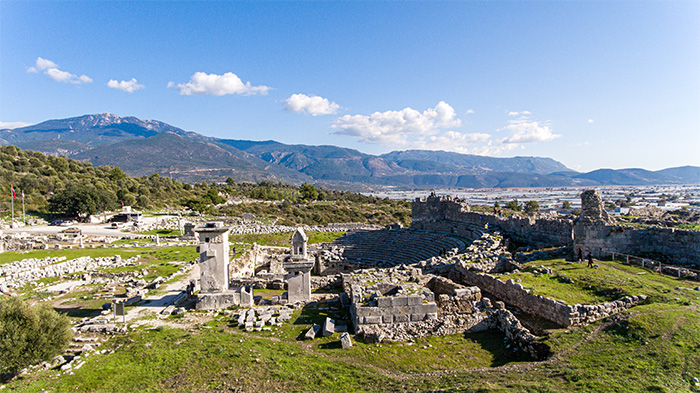Antalya Province is located in south-west Türkiye, along the Mediterranean coast. In the past, the region was the location of the ancient lands of Pamphylia in the east and Lycia in the west, but it has also been ruled by a number of different civilisations throughout its long history, and today is home to many stunning archaeological sites and ancient ruins.

Kaleiçi The city of Antalya takes its name from the earlier Attalia, which was founded as a seaport in the 2nd century BC by Attalus II, a king of Pergamum, although archaeological excavations carried out in the city centre in recent years indicate that its history dates back as far as the 5th century BC. Attalia was bequeathed to the Romans by Attalus II’s nephew, Attalus III, upon his death in 113 BC, and over time the city has also been controlled by the Seljuks and the Ottoman Empire, to name just a few. The historic city centre of Antalya, known as Kaleiçi, is home to an array of ancient sites and monuments. The first signs of Antalya’s rich past are the ancient walls surrounding Kaleiçi, which encircled almost the whole city until the modern period. The walls also include the city’s only remaining ancient entrance, Hadrian’s Gate, which was built in AD 130, in honour of a visit to the city by Emperor Hadrian, although the upper part of the structure was rebuilt in the 13th century.

Once you are inside the ancient city centre, one of the most significant historic attractions is the Yivli Minaret Complex (Yivli Minare Külliyesi), which encompasses a collection of buildings from the Seljuk period, including the Yivli Minaret, a 40m tall structure that is one of the traditional symbols of the city. Also worth a visit is Karaalioğlu Park, a large park on the south-west side of Kaleiçi, which is home to Hıdırlık Tower (Hıdırlık Kulesi). The tower was built in the 2nd century AD and has been used as a fortification and a lighthouse over the course of its history. Xanthos and Letoon Several hundred kilometers away, in south-west Antalya, lie the ancient city of Xanthos, and its cult centre, Letoon, in neighbouring Muğla province, which was added to the UNESCO World Heritage list in 1988. Xanthos dates back to 3,000 BC and was once the capital of the ancient kingdom of Lycia, but the site also contains plenty of Hellenistic and Roman architecture, including the Xanthos theatre (Xanthos Tiyatrosu), the Roman agora, and a mausoleum featuring unique examples of funerary architecture. Meanwhile, Letoon was an important religious sanctuary in antiquity, with finds dating back to the 6th century BC and a number of ancient temples and cult buildings still standing today, most significantly, the three temples dedicated to Artemis, Apollo, and their mother, Leto. Xanthos and Letoon also contain many inscriptions carved into rocks and stone pillars, which represent some of the longest and most important examples of the ancient Lycian language.

Myra and Patara The region is also home to sites of later religious significance, such as Myra and Patara, which gained fame because of their connection to the early Christian bishop who became Saint Nicholas, a popular saint in many European countries, perhaps best-known today for his association with beliefs surrounding Santa Claus.

Patara was the birthplace of Saint Nicholas in the 3rd century AD and the city became an important centre for Christianity in the Byzantine period. Its history stretches back much further than this though, as it was one of the oldest – and largest – cities in Lycia, with origins dating back to before the Iron Age. It is also home to perhaps the oldest surviving lighthouse in the world, built by Emperor Nero in AD 46, which is currently being reconstructed. Patara’s excellent location as a harbour, as well as its identity as the mythical birthplace of Apollo, also contributes to the city’s unique importance. Patara was the capital of Lycia during the Roman period and is the centre where the Lycian League – the first known example of modern democracy – was assembled. Myra is famous as the place where Saint Nicholas was made a bishop and is the site of the Saint Nicholas Church, built 200 years after his death. This 6th-century church is an important example of Eastern Roman art and architecture, but Myra was also an important Lycian city, and today is well known for its Lycian rock-cut tombs and ruins from the Roman period.


Other sites
These are just a few of the many historical gems in the region. Antalya is also home to impressive examples of Seljuk architecture such as Alara Castle and Alanya Castle, as well as numerous sites with ruins dating back to classical antiquity such as Perge, Aspendos, Termessos, and Side, and other settlements with earlier Lycian origins and remains, including Arykanda, Limyra, Olympus, Phaselis, Sillyon, and Simena. The area’s history also stretches back into the much more distant past; at Karain Cave, 30km north-west of Antalya’s city centre, evidence has been found of human occupation going back 25,000 years, as well as Neanderthals’ presence hundreds of thousands of years ago.

Finally, a trip to the region would not be complete without a visit to the Antalya Archaeological Museum. Founded in 1922, the museum now consists of 14 exhibition halls covering an area of 30,000m2, with open-air galleries, and a garden. Inside, the museum presents thousands of years of history in the province of Antalya through objects, sculptures, and artworks discovered in the region.

